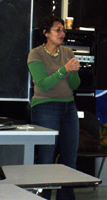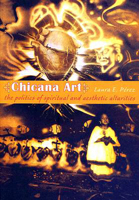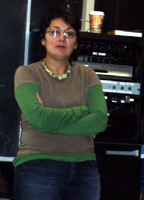
AUDIO RECORDING:
Laura Pérez on Chicana Art: The Politics of Spiritual and Aesthetic Altarities
LECTURE & Q&A AT CAL STATE UNIVERSITY, NORTHRIDGE, CHICANA/O STUDIES DEPT
17
o c t o b e r 2007



Laura Pérez;
cover of Chicana Art: The Politics of Spiritual and Aesthetic Altarities
AUDIO: LAURA PÉREZ
To listen to the lecture, click below (right/ctrl-click to download):
LECTURE [39:17; 36 mb]-
SLIDESHOW [17:25; 16 mb]-
Q&A, PT. 1 [33:07; 30.3 mb]-
Q&A, PT. 2 [22:34; 20.7 mb]-
TEXT: CHICANA ART
As part of Dr. Mary Pardo's Chicana/o Studies 500 graduate-level course at CSUN, we were very fortunate to have a visit from scholar and poet Laura Pérez this week, a 21 st century tlacuilo/tlamatini poet-sage who discussed and lectured on her newly published monograph, Chicana Art: The Politics of Spiritual and Aesthetic Altarities.
Put simply, this book is one of the most important works ever written on Chicana art.
As Pérez explains, like the “sacrifical ofrenda [s]” of the Chicana artists whose work she presents and analyzes here as “transmutation of social personal suffering into penetrating visions of the present and brave sightings of hopeful, better futures” (6), this book was constructed and functions as a kind of altar, at once a glyph and a decoding, that links artistic practice, academic discourse, and radical political and social justice work.
Aesthetically, Chicana Art is a beautiful, quite stunningly constructed (and yet relatively inexpensive) archive of Chicana art from 1965 to the present, with a particular focus on the period between 1985 and 2000. In terms of analysis and theory, Pérez' previous scholarly work focused on the subversive practices of “the historical avant-gardes of Europe and Latin America, those of the first four decades of the twentieth century” (10), particularly in Nicaragua, and she identifies the theoretical “unseen marrow” of this current work on Chicana artists as the heirs of these avant-garde traditions: “Dada-, Cubist-, Surrealist- and other vanguardia -inspired postructuralist, postcolonial, and postmodern thinkers—and the spiritually guided, courageous social justice work of such nonviolent activists and gender-bending intellectuals as Mohandas Gandhi, Martin Luther King Jr., César Chávez, and Mother Teresa…” (11) among others.
However, while the avant-garde grounding in socially and politically focused subversive art serves as a theoretical underpinning, again, like the spiritually based work of the Chicana artists that Pérez examines, it is the spiritual dimensions and focus of her book that function to effect a radical epistemological transmission, “offering what to many are still ‘foreign' and suspect, and thus unintelligible, knowledges: the cultural ‘differences' of the non-Western, the female, the queer, and the poor” (6). Discussing how they function in the work of Chicana artists, Pérez notes that “[t]hese knowledges, which are as old as humanity, and which have outlived pseudoscientific and culturally parochial philosophies that rationalize imperialist capitalism and racism and consign the non-Western to the primitive prehistory of civilized ‘man,' remain as alternatives to the growing solitude, alienation, despair, and illness of too many in today's societies of rampant consumerism, spiritual emptiness, ethical confusion, and the visible crimes and duplicities of government, big business, and institutional religion” (6–7).
One of the key points that Pérez makes is her assertion that through the transmission and discourse of these alternative epistemologies, Chicana artists “redefine the social role of art and artist in more complex, more ambitious, and more politically and spiritually significant ways than are culturally dominant in the United States and other parts of the world” (46). This redefinition of the artist's role runs directly counter to the Eurocentric construction of the artist as individualistic—whether as an approved, corporate-bought, artworld “star,” or as an isolated, alienated, “starving artist.” I have seen firsthand how many of these, and other, Chicana/o artists, work to effect this redefinition through a complex, spiritual artistic practice of subversive community-building, mentoring, glyph-making, decoding, and transmission of alternative knowledges that convey tactics of not only survival and resistance, but of a technologically sophisticated re-membering that, rather than being nostalgic, functions to help us decolonize and defragment our selves, and to reconnect us with unified existence in the context of our current situation. In this, I agree with Pérez' assertion that while the process has so far been largely (but not surprisingly) unacknowledged/ignored, what constitutes “avant-garde” practice has been radically redefined by Chicana/o artists over the last twenty years or so through an intertwining of spiritual-, political-, and social justice-focused elements and art practices, in ways that leave the traditionally acknowledged (Euro) avant-garde in the dust of the previous century/ies.
Another key point Pérez focuses on is the relationship between spirituality and the concept of difrasismos—the juxtaposition of two elements in order to point to another, third, concept/reality/experience. This relates to the concept of using signs/symbols to point beyond the system of signs/symbols, and to the Mexica reliance on the language of flor y canto, poetry and song—art—to express that which cannot be articulated or figured in “normal” speech, writing, and other uses of language.
Pérez will be lecturing and signing her book at Trópico de Nopal this Friday, October 19, at 8 p.m. According to the flyer, many of the Chicana artists in the book will be present at this event, and their work will be on display for the evening. I highly recommend getting out to Trópico for this.
Trópico de Nopal: 1665 Beverly Blvd., L.A. (Echo Park), 90026 • 213.481.8112
http://www.tropicodenopal.com
MORE QUOTES FROM CHICANA ART:
“The notion of the spiritual that I wish to discuss here, as it is invoked in contemporary Chicana writing and visual art, derives its inspiration primarily from Mesoamerican, other American Indian, African diasporic, and feminist critiques of traditional religiosities emphasizing the belief that there exists an essential spiritual nature, and thus an interconnectedness, of all beings, human and nonhuman.” (18)
“The linkages within imperialist and racist thinking between the spiritual, the female, and peoples of color are what make the conditions for talking about women, particularly women of color, and the spiritual, especially difficult.” (19)
“The ‘spirit work' of Chicana visual, performing, and literary artists studied here counters the trivialization of the spiritual, particularly of beliefs and practices from non-Western traditions, as ‘folk religion,' ‘superstitious,' or ‘primitive.' It attempts to derail Eurocentric cultural evolutionary arguments in the sphere of religious belief or disbelief that demean that which is culturally different as inferior.” (20)
“In numerous ways that include the invocation of reworking of pre-Columbian Mesoamerican notions of art and art making represented in glyphs, and the Mexica (‘Aztec') figures of the tlacuilo (glyph-maker) and the tlamatini (sage, decoder of the glyphs), these artists are ‘spirit tongues' of a metadiscourse of art whose social role is more broadly conceived and engaged than that of much presently celebrated contemporary art in hegemonic Euroamerican and Euro-dominated cultures. The writers and artists studied [here]… structure their work like the painter-scribes of Mesoamerica, particularly those of the immediate aftermath of the Spanish invasion, in that the glyphs they trace, like those painted by the Nahua tlacuilo , are signs that always point beyond the sign system itself to things that cannot be fully figured. Chicana work inscribing culturally different and politically challenging views of art and spirituality points beyond Euro-dominated languages and worldviews tot the necessity of a more complex hermeneutics, one that is cross-cultural, interdisciplinary, and beyond racist, sexist, and heterosexist myopias.” (22)
“[T]he invocation of the spiritual in the work of Chicana artists studied here is political significant, socially transformative, and psychically healing. We are pushed by such work beyond the increasingly familiar, if still relevant, observations about the survival, resistance, and opposition of the socially abject other.” (25)